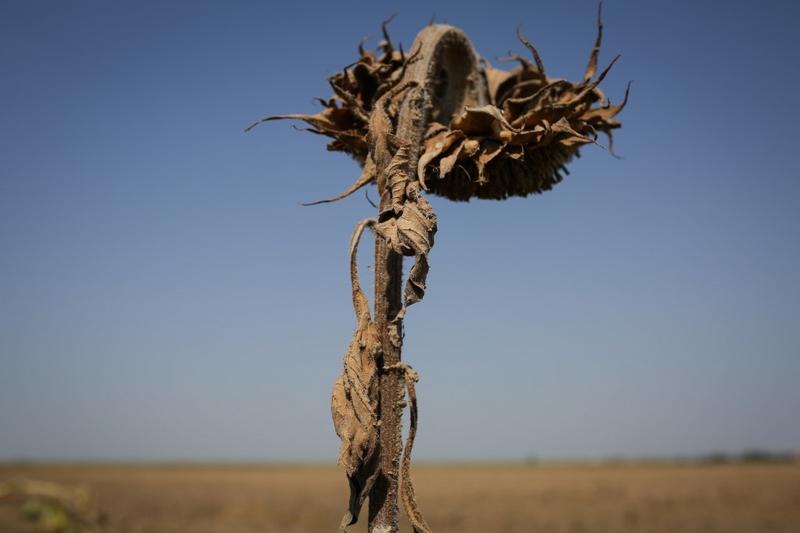 In this undated photo, an agricultural worker shovels grain in Agigea, Romania. (PHOTO / BLOOMBERG)
In this undated photo, an agricultural worker shovels grain in Agigea, Romania. (PHOTO / BLOOMBERG)
First the virus lockdown shuttered the two dairies where farmer Gavrila Tuchilus sells the milk from his 1,500 cows. Then his fields dried up, forcing him to abandon his barley crop for the first time in 39 years.
“A double war is taking place,” said Tuchilus, from Matca, a village in southeast Romania. “It’s a war against the invisible COVID-19 and a war with the drought.”
The dry spell that’s scorching parts of the European Union’s eastern wing is devastating harvests and exacerbating what’s expected to be the region’s deepest economic downturn.
In parts of Romania and Poland, the drought is the worst in a century. In the Czech Republic it’s the worst in five. It’s raising questions of how to ensure food security in a region with painful memories of both food shortages under totalitarian regimes and the more recent scramble for medicine and protective gear to fight against the coronavirus.
This will become a huge topic. No one will instantly produce food if there’s an emergency
Martin Pycha, Head of the Agricultural Association of the Czech Republic
ALSO READ: Tree-planting programs defy deserts and drought
“This will become a huge topic,” said Martin Pycha, the head of the Agricultural Association of the Czech Republic. “No one will instantly produce food if there’s an emergency.”
Panic Buying
With memories still fresh of starvation under late Romanian dictator Nicolae Ceausescu, people swept grocery store shelves clean of staples when the government locked down the economy and told people to stay at home.
Then the drought hit, and the EU’s second-biggest wheat exporter -- where agriculture makes up about 5 percent of output -- forecast the wheat harvest could plunge to half of the average 9 million tons a year.
That prompted the government to briefly ban exports to destinations outside the European Union in March, sending ripples across global commodities markets and bringing a rebuke from the European Commission.
It didn’t trigger a major impact on trade, with Bucharest ending the ban a week later and large harvests in many nations are expected to push global stockpiles to new records this year and next. Still, the double drought-virus punch has brought agriculture again to the fore in European politics.
Eastern EU states have avoided the high Covid-19 death tolls with early and strict quarantine measures, a development that prompted Czech President Milos Zeman to declare the drought a worse crisis than coronavirus. He called on Prime Minister Andrej Babis’s government to build new reservoirs.
In Poland, the bloc’s largest eastern member and home to more than 2 million farmers, the grain crop is expected to drop more than 8 percent this year, according to the Warsaw-based Institute of Agriculture and Food Economics.
That may prompt Warsaw to demand more go to farming in the EU’s 2021-2027 budget -- a proposition that will face an uphill struggle to gain support given that agriculture is already the biggest single item in the spending plan.
“I’ve just sent a letter to Ursula von der Leyen and 26 EU leaders advocating a boost in spending on common agriculture policy during the next seven years,” Prime Minister Mateusz Morawiecki said last week, referring to the president of the European Commission. “We should support local, ecological food production and agriculture.”
Morawiecki’s administration has also asked the anti-monopoly watchdog to look into a spike in food prices, which are expected to rise 15 percent this year. That’s a worry in developing European countries, where people are forced to spend a bigger portion of their disposable income on food than in the richer West.
“The policies to protect against coronavirus which limit trade and the movement of goods and people are creating concerns with fresh produce, meat, fish and vegetables, whose prices are increasing,” Elena Conte, an economist at the Food and Agriculture Organization of the United Nations, said last week.
 In this file photo, cracked clay can be seen in a field in the village of Balaceanca, Romania, some 10 km south of the capital, Bucharest. (PHOTO / AFP)
In this file photo, cracked clay can be seen in a field in the village of Balaceanca, Romania, some 10 km south of the capital, Bucharest. (PHOTO / AFP)
Ban Risk
The continent’s biggest grain exporters abutting the EU’s borders, Ukraine and Russia, have been spared the worst of the drought, with late spring rain saving crops that were at risk of drying out.
Back in Romania, Tuchilus eventually found buyers for his milk. Fellow farmers like Dumitru Ene who’ve invested in irrigation technology -- an expensive process that many can’t afford in the EU’s third-poorest country -- have also had success.
READ MORE: Drought-stricken Australia endures driest spring in 120 yrs of records
“We’ve had years with drought before, though none as bad as this year,” Ene said. “But all this is worth it, as good contracts come along now.”
Still, Ene has already sold his entire crop this year. More worryingly, his phone hasn’t stopped ringing with calls from prospective buyers, signaling supply is tight. With Romanian inventories barely replenished and harvest yields expected to suffer, there’s still the real potential of a new export ban.
“We’ll take more measures to ensure we have sufficient stockpiles,” Romanian Agriculture Minister Adrian Oros warned on May 12. “We’re monitoring, and we’re ready to ban grain exports again if we think our food safety is in jeopardy.”



